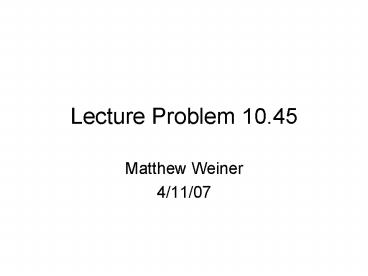Lecture Problem 10'45 PowerPoint PPT Presentation
1 / 14
Title: Lecture Problem 10'45
1
Lecture Problem 10.45
- Matthew Weiner
- 4/11/07
2
Problem Statement
- From the phase diagram for the MgO-Al2O3 system,
it may be noted that the spinel solid solution
(MgAl2O4) exists over a range of compositions,
which means that it is nonstoichiometric at
compositions other than 50 mol MgO-50 mol
Al2O3. - The maximum nonstoichiometry on the Al2O3-rich
side of the spinel phase field exists at about
2000 degrees C corresponding to approximately 82
mol (92 wt) Al2O3. Determine the type of
vacancy defect that is produced and the
percentage of vacancies that exist at this
composition. - The maximum nonstoichiometry on the MgO rich side
of the spinel phase field exists at about 2000
degrees C corresponding to approximately 39 mol
(62 wt) Al2O3. Determine the type of vacancy
defect that is produced and the percentage of
vacancies that exist at this composition.
3
Important Information
- For the first part of the problem, we will be
interested in the region of the phase diagram at
82 mol Al2O3 - For the second part, we will be interested in the
39 mol Al2O3 region
4
MgO Al2O3 Phase Diagram
5
Part A
- Type of Vacancy Created
- Since the compound is Al2O3-rich, some Mg2 must
be removed so that there can be room for more
Al3 (Al3 substitutes for Mg2) - The overall charge must be kept neutral, so for
every 2 Al3 added, 3 Mg2 must be removed - ? There are Mg2 vacancies (cation vacancy)
6
Part A (cont)
- Choose a basis to get an expression for mole
fraction - Use 100 mol of MgO-Al2O3, which means there are
100 mol MgO and 100 mol Al2O3 - If 3 Mg2 need to be removed for every 2 Al3
added, then for every mol of Al2O3 formed, 3
moles of MgO need to be removed (the O2- lattice
stays the same)
7
Part A (cont)
- Write the mole fraction of Al2O3 in terms of the
number of moles of Al2O3 created past 50 mol
Al2O3-50 mol MgO
8
Part A (cont)
- Solve the Al2O3 mole fraction equation for a mole
fraction of 82 (given in problem statement) - Since three moles of MgO are removed for every
mole of Al2O3 created, 72.72 mols of Mg2 were
removed - This means a total of 72.72-48.48 24.24 mols of
vacancies were created
9
Part A (concluded)
- The fraction of vacancies is equal to the number
of vacancies over the total number of sites that
Mg2 could occupy - 100 mol sites from the 100 mol of MgO
- 200 mol sites from the 100 mol of Al2O3
- So, the percentage of vacancies is
10
Part B
- Now, we are looking at the MgO-rich side of the
spinel phase diagram - The Mg2 will be replacing the Al3
- If two Al3 are removed to allow 2 Mg2 to come
in, there is still a net -2 charge, so one O2-
must be removed as well - ?There are O2- vacancies (anion vacancy)
11
Part B (cont)
- For every 2 Mg2 added, 1 O2- will be removed, so
we can write the equation for the mole fraction
of MgO
12
Part B (cont)
- Since we are looking at 39 mol Al2O3, the spinel
is 61 mol MgO - Setting the above equation equal to 0.61
- Since the amount of O2- removed is half the
amount of Mg2 added, 15.8 moles of O2- were
removed
13
Part B (concluded)
- Follow the same steps as in Part A to find the
percentage of vacancies - There are 100 mol sites for O2- in MgO and 300
mol sites for O2- in Al2O3 - The percentage of vacancies is
14
Applications
- Can analyze the phase diagram for a ceramic
system like for a metal-metal system - With an increase in the number of vacancies, the
diffusivity increases - Conductivity increases (undesired effect for an
insulator)

